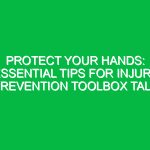Introduction
Construction toolbox talks are brief, informal discussions focused on safety and health issues that arise during construction projects. They serve as a vital communication tool within the Health, Safety, and Environment (HSE) domain. These talks help to educate workers about specific safety topics, enhance awareness of potential hazards, and foster a culture of safety on-site. In an industry where risks are prevalent, effective toolbox talks can significantly reduce accidents, injuries, and fatalities.
Engaging in regular toolbox talks not only aligns with regulatory requirements but also demonstrates a commitment to employee well-being and environmental stewardship. This article delves into the essential aspects of construction toolbox talks, exploring their importance, content, best practices, and regulations that govern them.
The Importance of Toolbox Talks in HSE
Toolbox talks are particularly important in the construction industry due to the dynamic and often hazardous nature of the work environment. These talks provide an opportunity for open dialogue between workers and supervisors, fostering a collaborative approach to safety. Here are key reasons why toolbox talks are crucial:
- Risk Awareness: They raise awareness about specific hazards present on the job site, ensuring that workers understand the risks they face daily.
- Knowledge Sharing: Toolbox talks facilitate the sharing of information and experiences among team members, which can lead to improved safety practices.
- Compliance: Regular toolbox talks help organizations comply with occupational health and safety regulations, reducing the likelihood of legal issues.
- Engagement: These discussions encourage worker participation and engagement, which is essential for instilling a culture of safety.
Key Components of Effective Toolbox Talks
To maximize the effectiveness of construction toolbox talks, certain components should be included. These elements ensure that the talks are relevant, engaging, and informative.
1. Relevant Topics
Selecting appropriate topics is crucial for the success of toolbox talks. Topics should be relevant to the current work being performed, recent incidents, seasonal hazards, or specific safety concerns. Examples include:
- Working at heights
- Electrical safety
- Personal protective equipment (PPE)
- Hazardous materials handling
2. Clear Communication
Effective communication is key. The language used during toolbox talks should be straightforward, avoiding technical jargon unless necessary. Utilize visuals, such as charts or videos, to enhance understanding.
3. Engagement Techniques
Engaging participants is essential for effective learning. Encourage questions, discussions, and even role-playing scenarios. This interaction keeps workers attentive and fosters a deeper understanding of safety practices.
4. Documentation
Documenting toolbox talks is vital for compliance and record-keeping. Maintain a log that includes the date, topics covered, names of attendees, and any notable discussions. This documentation can serve as a reference for future talks and audits.
Best Practices for Toolbox Talks
Implementing best practices can enhance the effectiveness of toolbox talks. Here are several strategies to consider:
1. Schedule Regular Talks
Establish a routine for toolbox talks. Whether daily, weekly, or bi-weekly, consistency helps reinforce the importance of safety. Consider timing them before work begins to ensure maximum participation.
2. Tailor Content to Your Audience
Understanding your audience is crucial. Tailor discussions to the specific group of workers present. For instance, a talk for experienced workers may differ significantly from one aimed at new hires.
3. Incorporate Real-Life Examples
Using real-life examples or incidents can drive home the importance of safety. Sharing stories of past accidents or near misses can motivate workers to take safety seriously.
4. Foster a Culture of Safety
Encourage a culture where safety is a shared responsibility. Acknowledge workers who demonstrate safe practices and encourage them to share their safety experiences during toolbox talks.
Potential Hazards and Safety Considerations
Construction sites present numerous hazards that toolbox talks can address. Identifying these risks is essential for minimizing accidents. Common hazards include:
- Slips, Trips, and Falls: These are among the most common causes of injury. Toolbox talks can cover safe walking practices, proper footwear, and the importance of keeping work areas tidy.
- Struck by Objects: Workers can be injured by falling tools or materials. Discuss the importance of securing tools and using barriers.
- Electrical Hazards: Working with electricity poses significant risks. Talk about safe practices when working near power lines or using electrical equipment.
- Hazardous Materials: Many construction sites involve chemicals and other hazardous materials. Discuss the importance of proper handling, storage, and disposal methods.
Regulations and Standards Governing Toolbox Talks
Various regulations and standards govern the implementation of toolbox talks within the HSE context. Understanding these can help organizations stay compliant and maintain high safety standards.
1. Occupational Safety and Health Administration (OSHA)
In the United States, OSHA sets forth regulations that require employers to provide a safe workplace. While OSHA does not specifically mandate toolbox talks, they play a crucial role in meeting safety training requirements.
2. ISO Standards
The International Organization for Standardization (ISO) has established standards, such as ISO 45001, which focuses on occupational health and safety management systems. Implementing toolbox talks aligns with the principles of continuous improvement and employee engagement outlined in these standards.
3. Local Regulations
Many local jurisdictions have their own safety regulations that may require regular safety training and meetings. Organizations must familiarize themselves with these requirements to ensure compliance.
Conclusion
In summary, construction toolbox talks are a fundamental element of health, safety, and environmental success in the construction industry. By focusing on relevant topics, engaging workers, and adhering to best practices, organizations can foster a culture of safety that reduces risks and enhances overall performance.
The importance of toolbox talks cannot be overstated. They serve not only as a means of compliance with regulations but also as a proactive approach to ensuring the well-being of workers and the environment. As the construction industry continues to evolve, embracing toolbox talks as a core part of safety practices will be essential for mitigating risks and promoting a sustainable future.
Encouraging open dialogue, sharing knowledge, and actively engaging in these discussions can lead to a safer and more productive work environment. Organizations should continually strive to improve their toolbox talks, adapting to the changing landscape of construction work and the unique challenges it presents. Through dedication and commitment to safety, the industry can work towards achieving HSE success.


